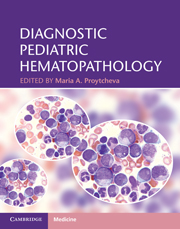Book contents
- Frontmatter
- Contents
- List of contributors
- Acknowledgements
- Introduction
- Section 1 General and non-neoplastic hematopathology
- Section 2 Neoplastic hematopathology
- 10 Chromosome abnormalities of hematologic malignancies
- 11 Expression profiling in pediatric acute leukemias
- 12 Myeloproliferative neoplasms
- 13 Myelodysplastic/myeloproliferative neoplasms
- 14 Myelodysplastic syndromes and therapy-related myeloid neoplasms
- 15 Acute myeloid leukemia and related precursor neoplasms
- 16 Hematologic abnormalities in individuals with Down syndrome
- 17 Precursor lymphoid neoplasms
- 18 Advances in prognostication and treatment of pediatric acute leukemia
- 19 The effect of chemotherapy, detection of minimal residual disease, and hematopoietic stem cell transplantation
- 20 Pediatric small blue cell tumors metastatic to the bone marrow
- 21 Pediatric mature B-cell non-Hodgkin lymphomas
- 22 Pediatric mature T-cell and NK-cell non-Hodgkin lymphomas
- 23 Hodgkin lymphoma
- 24 Immunodeficiency-associated lymphoproliferative disorders
- 25 Histiocytic proliferations in childhood
- 26 Cutaneous and subcutaneous lymphomas in children
- Index
- References
12 - Myeloproliferative neoplasms
from Section 2 - Neoplastic hematopathology
Published online by Cambridge University Press: 03 May 2011
- Frontmatter
- Contents
- List of contributors
- Acknowledgements
- Introduction
- Section 1 General and non-neoplastic hematopathology
- Section 2 Neoplastic hematopathology
- 10 Chromosome abnormalities of hematologic malignancies
- 11 Expression profiling in pediatric acute leukemias
- 12 Myeloproliferative neoplasms
- 13 Myelodysplastic/myeloproliferative neoplasms
- 14 Myelodysplastic syndromes and therapy-related myeloid neoplasms
- 15 Acute myeloid leukemia and related precursor neoplasms
- 16 Hematologic abnormalities in individuals with Down syndrome
- 17 Precursor lymphoid neoplasms
- 18 Advances in prognostication and treatment of pediatric acute leukemia
- 19 The effect of chemotherapy, detection of minimal residual disease, and hematopoietic stem cell transplantation
- 20 Pediatric small blue cell tumors metastatic to the bone marrow
- 21 Pediatric mature B-cell non-Hodgkin lymphomas
- 22 Pediatric mature T-cell and NK-cell non-Hodgkin lymphomas
- 23 Hodgkin lymphoma
- 24 Immunodeficiency-associated lymphoproliferative disorders
- 25 Histiocytic proliferations in childhood
- 26 Cutaneous and subcutaneous lymphomas in children
- Index
- References
Summary
Introduction
Although hematologic malignancies are collectively the most common neoplasms of childhood, comprising approximately one-fourth to one-third of all cases of pediatric cancer in the USA, the myeloproliferative neoplasms, formerly termed chronic myeloproliferative disorders, are distinctly rare in the pediatric setting [1, 2]. Among the seven entities recognized by the 2008 WHO classification of myeloproliferative neoplasms (Table 12.1), chronic myelogenous leukemia and mastocytosis are the only ones encountered with any regularity in the pediatric population. Primary myelofibrosis, polycythemia vera, and essential thrombocythemia are very uncommon in children, and chronic neutrophilic leukemia and chronic eosinophilic leukemia are extraordinarily rare in this population, the description of which is limited to an occasional case report [3]. Several pediatric “myeloproliferative” disorders are not truly neoplastic, and as such they have a pathogenesis distinct from their bona fide neoplastic counterparts in adults. The application to these pediatric disorders of the same terminology employed for adult myeloproliferative neoplasms, which are by definition clonal and neoplastic, creates confusion with regard to their pathogenesis, clinical behavior, and appropriate treatment. Our discussion of pediatric myeloproliferative neoplasms will focus almost exclusively on those disorders seen in children, with emphasis on the distinctive aspects of the pediatric forms of these disorders, as well as conditions which can mimic true pediatric myeloproliferative neoplasms. Myeloproliferative neoplasms which are exceedingly rare in children (e.g., chronic neutrophilic leukemia) will not be discussed.
- Type
- Chapter
- Information
- Diagnostic Pediatric Hematopathology , pp. 217 - 244Publisher: Cambridge University PressPrint publication year: 2011



